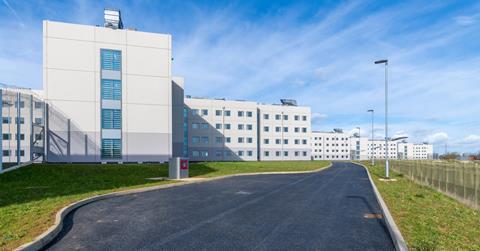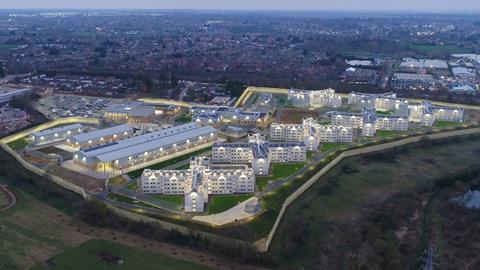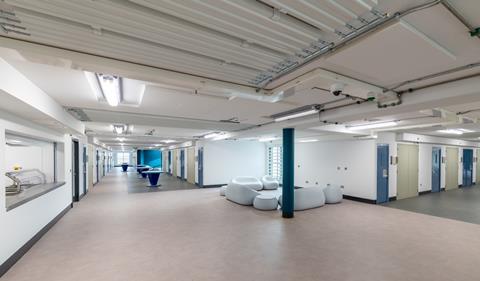Digital twins have the potential to operate buildings more efficiently than traditional facilities management systems. The MoJ is trialling the technology at its Five Wells prison and the early indications are looking good

Using digital information from a building’s design and construction phase to operate and maintain it more efficiently has the greatest potential to save clients money because these costs add up significantly over a building’s life. This is the reason why the government required designers and contractors to hand it over using a protocol called Cobie (construction operations building information exchange) as part of the 2016 BIM mandate.
The idea was for this information to be used to populate facilities management tools for building operation. Since 2016 digital twins have come on the scene as a more sophisticated and effective tool for managing buildings after handover compared with traditional computer-aided management tools.
>> Also read: Digital construction: are we nearly there yet?
A digital twin is a digital representation – or twin – of a physical asset and can be used to operate and maintain buildings. The digital twin – a digital model of the building, usually the one used for its design and construction – is linked to the physical building by an array of sensors and a management system. The twin is constantly informed about the actual state of the building, assessing factors such as temperature and air quality, and so can make adjustments in real time. It can also flag problems with building systems and be used for predictive maintenance to mitigate the risks of component failures.
Despite the clear advantages, digital twins are still not widely used. However the Ministry of Justice, the government department that has become a trailblazer for improving productivity through MMC and digital technologies, aims to change that by pioneering the use of digital twins to improve the operational efficiency of its prisons.
We’ve got a 100% accurate asset information model and we’ve also got an intelligent building with a complex building management system and lots of data points
James Franklin, digital construction lead, Kier
The MoJ is trialling a digital twin on HMP Five Wells in Northamptonshire in partnership with Kier, the contractor that built the prison and handed it over in 2021. This was a pioneering project in its own right because the prison was constructed using 80% standardised precast components that were optimised to minimise follow-on work. It was also delivered with digital tools including BIM.
This made it an ideal candidate for a digital twin thanks to a complete set of as-built digital data that could be used to populate the twin. “We’ve got a 100% accurate asset information model and we’ve also got an intelligent building with a complex building management system and lots of data points,” explains James Franklin, digital construction lead for Kier.
“We thought we could bring those two things together to help create a digital twin and an example for the MoJ.”

Gareth Jones, the head of MMC and technical services for the MoJ, says the team needed a manageable focus for the first phase of the project because digital twins can manage so many aspects of building operation. It picked carbon emissions given that the MoJ has a target to reduce these by 38% by 2025.
“We picked energy and carbon as our starting point but, as we’ve gone through the journey and through engagement with various stakeholders within the MoJ, we’ve realised there is a lot of potential that could come from digital twins beyond just energy and carbon,” Jones says
The project started as an idea in January last year and, by March, a dedicated group had been formed to make it happen. The digital twin started operating in July.
Six months has now elapsed and Kier and the MoJ have the results of this first phase ready to inform the second phase – making changes to the building’s systems to reduce energy use. The third phase will integrate AI technology to help control building systems.
This will learn from the data from building operation, enabling it to make predictions about how the building is being used so that it can instruct the building management systems accordingly, saving more energy. Lighting control might be added at this stage too.
Making the prison digital twin-ready required the input of several specialists. “There is sometimes a misconception that a digital twin is just a piece of technology,” Jones says.
“We realised very quickly in our journey that it is a collective of specialists that make this work. There are four parties – the client, the systems hardware specialist, technology specialists and building physicists – who understand the building operation and advise accordingly.”
The building already included some sensor technology but more was needed on the air handling units to monitor carbon dioxide levels. Interfaces were created between the building management system and the asset information model which includes as-built digital information.
The digital twin is hosted on a platform called Glider and a specialist in building physics called Future Decision runs the analytics platform which is linked to the digital twin and building systems. These take live building data and analyse where energy savings can be made.

Franklin says that digital twin technology eliminates the data transfer issues associated with traditional computer-aided facilities management systems as the asset information model is the foundation for the digital twin.
“There has been a challenge in taking BIM from design and construction into operation and I think digital twins can really help streamline that process from design, construction into operation and make something that’s really useable and brings out the lifecycle benefits that we were all sold on from the original outset of BIM,” he says.
Results from this first phase have identified potential savings from the ventilation and hot water systems. Franklin reckons changes planned for phase two should realise a 20% saving.
The ventilation and hot water systems currently operate on a scheduled basis rather than being demand driven. Lessons learnt from phase one mean these systems will be configured to adapt supply to match demand.
The early indications are that it provides real benefit to the MoJ and potentially gives us an opportunity to offer a blueprint to wider government property assets as well
Gareth Jones, head of MMC and technical services at the MoJ
“We think that, as we get into phase two with access to more data, we’ll be able to identify additional savings. We don’t think it stops there, but these are the things that we can stand behind at this point in in in the programme,” Franklin says.
A 20% saving will add up to a carbon saving of 198kg/CO2 per person per year. The team reckon the integration of AI into building systems in phase three will push the savings up to 37%.
“The early indications are that it provides real benefit to the MoJ and potentially gives us an opportunity to offer a blueprint to wider government property assets as well,” Jones says.

There could be other benefits, including improving conditions for inmates. “We’ve just done some early mapping looking at whether there’s any correlation between temperature and CO2 levels and how that perhaps could impact occupants’ sleep, their ability to learn and rehabilitate and their behaviour,” Jones says.
The first phase of the project shows the operational efficiencies that digital twins can bring to the MoJ estate and demonstrate that it is worthwhile. Post phase three of the project, the technology will be tested on existing buildings. This would involve more work as a digital model of the building needs creating using point scans and to be populated with information about the services.
It would also involve upgrading building management systems and fitting sensors. Longer term, data gathered from operating and perhaps maintaining prisons as well could be fed back into standardised designs so that these could be optimised to work with digital twin technology.
Most crucially, the lessons learnt from this project could see wider adoption of digital twins across the government estate, leading to a significant reduction in energy costs and carbon emissions.


























No comments yet